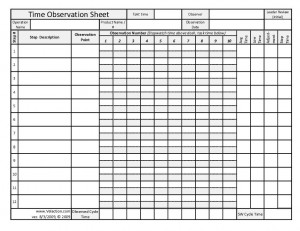Cycle Time Reduction
Cycle time reduction is the strategy of lowering the time it takes to perform a process in order to improve productivity.

In addition, cycle time reduction often improves quality. When a cycle time is too close to the takt time, there is little margin for error. If a process is dialed in with very little variation, this is seldom a problem. But most processes have some inconsistency in them, resulting in people falling behind the normal pace on occasion. This leads to them rushing, which, in turn can lead to mistakes. Reducing cycle time is a low-cost way to add a bit of a buffer to avoid those sorts of defects.
Standard Work provides the framework to do cycle time reduction. While simply stabilizing a process does not in and of itself reduce cycle time, it provides a foundation upon which to make improvements.
Cycle time reduction is accomplished through a variety of kaizen methods—jidoka (separating people from machines), improving manufacturing fixtures, redesigning parts to make them easier to assembly, improving software, poka yoking processes, and whatever else creative employees can think of.
One important point about productivity that you should remember. Simply reducing cycle time will not improve productivity. There has to be an accompanying change in staffing or increase in output for productivity to improve.
![]()
Cycle time is frequently determined using the Time Observation Sheet.




4 Comments
Bill · December 25, 2011 at 12:36 pm
I have read much on cycle time over the years and have come to the conclusion that it should be redefined. It is my belief that the actual time performing the task is all that should be counted. Historically/traditionally it is CT + Waiting time, Why? Yes I’m sure you could respond to this logically, but think about it. Does it make sense to you?
Jeff Hajek · December 25, 2011 at 8:46 pm
Bill,
I talk about this a bit in the cycle time term. I’ve seen cycle time broken down into processing time and wait time. In general, I consider the waiting within the process as part of the cycle (i.e. standing waiting for a machine to finish), but I don’t add the wait time between the end of the work and the beginning of the next shift/takt.
The internal waiting is required. The end waiting is something that could be immediately removed through increasing demand (shorter takt) or through line balancing.
Does that answer the question?
Jeff
Dhiraj Namdev · October 2, 2020 at 7:31 am
Jeff that was a nice answer!
Can I get to know more about continuous improvement techniques & different methods for reducing lead time?
Jeff Hajek · October 2, 2020 at 4:47 pm
Hi Dhiraj,
I have a lot of information here on this site, but the best way to learn more is to subscribe to my video service at https://video.velaction.com/. It has a lot of short videos and about half of the videos in my Lean Training System series. Actually, they are all there, but about half are part of the leader resources package and half are part of the basic subscription.
If you want the free route, I have a lot on my youtube channel (link at top of page), but many of the videos are excerpts from the content at Velaction Videos.
Thanks for the compliment and for your interest.